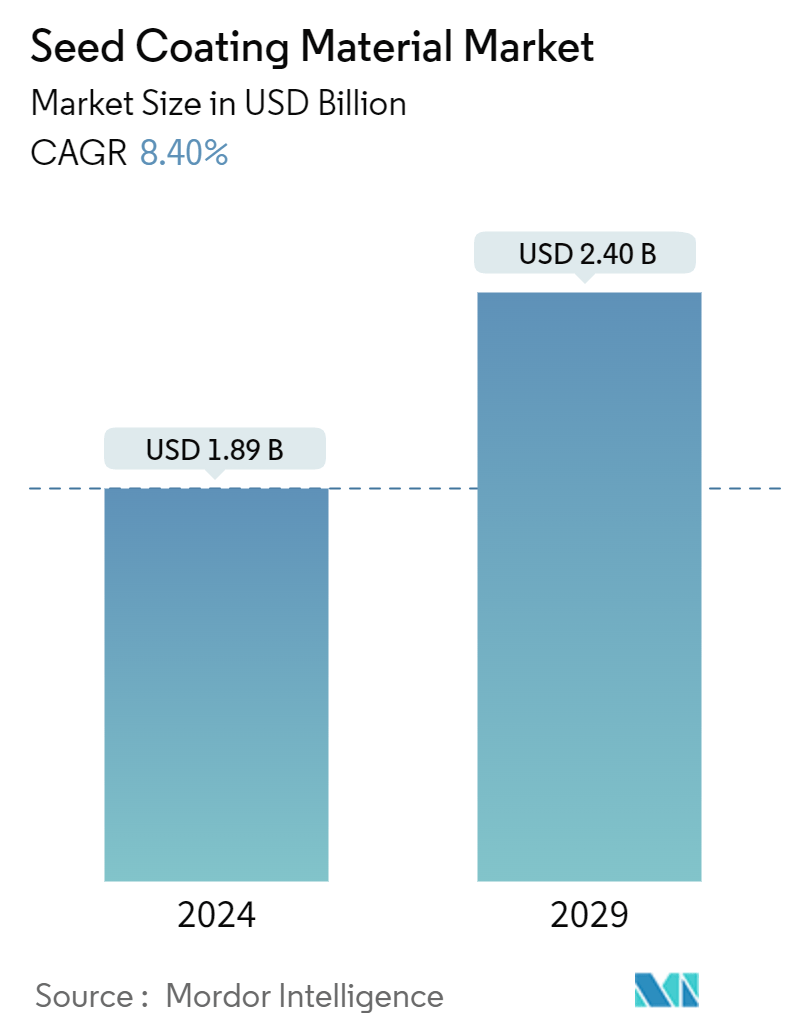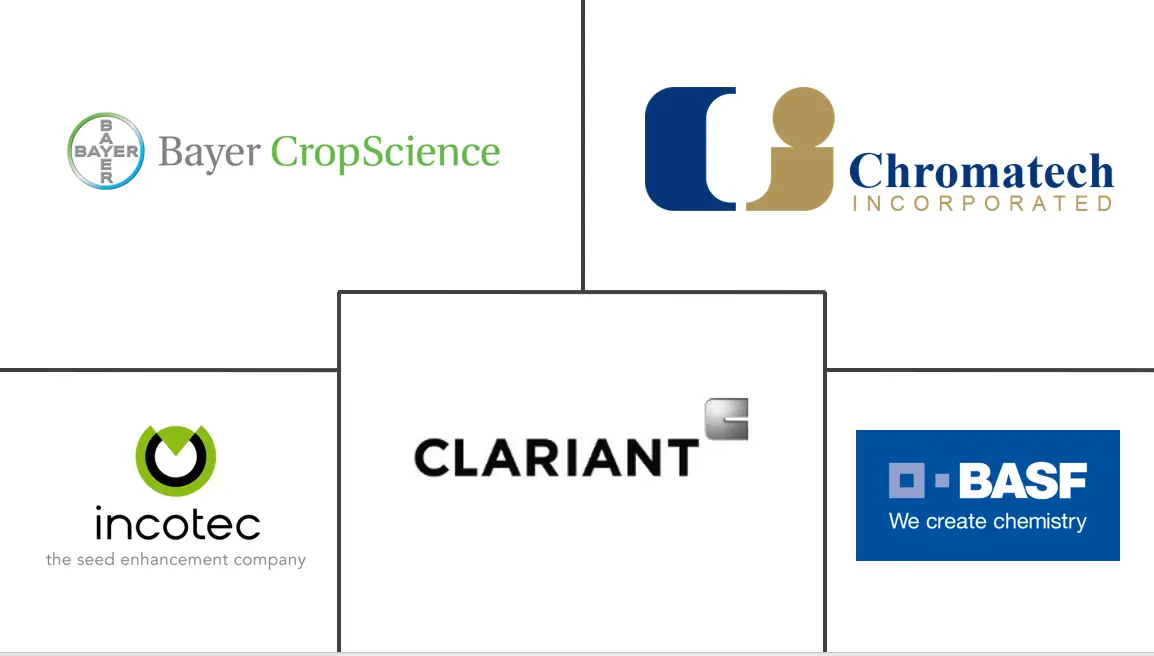Market Size of Seed Coating Material Industry

| Study Period | 2019 - 2029 |
| Market Size (2024) | USD 1.89 Billion |
| Market Size (2029) | USD 2.40 Billion |
| CAGR (2024 - 2029) | 8.40 % |
| Fastest Growing Market | Asia-Pacific |
| Largest Market | North America |
| Market Concentration | High |
Major Players
*Disclaimer: Major Players sorted in no particular order |
Seed Coating Material Market Analysis
The Seed Coating Material Market size is estimated at USD 1.89 billion in 2024, and is expected to reach USD 2.40 billion by 2029, at a CAGR of 8.40% during the forecast period (2024-2029).
- Drastic climate changes have adversely impacted growing conditions, leading to a heightened demand for high-quality seeds. These seeds can be enhanced through the adoption of seed-coating technology. As investments in agriculture rise and modern technologies become prevalent, farmers are increasingly aware of the benefits of material-coated seeds, genetically modified seeds, and hybrid seeds. For instance in February 2022, Croda International partnered with Xampla to develop a biodegradable seed coating, that is free from microplastics. This has facilitated the provision of sustainable solutions that comply with microplastic bans in several countries.
- The seed coating market is actively exploring innovative technologies to enhance the sustainability and efficiency of seed coatings in the field. One such technology is the Micro Emulsion Gel (MEG) technology. This method employs a gel-based coating infused with micro-emulsified active ingredients. Gaining traction in recent years for its sustainability and efficiency, MEG technology applies a thin gel film on seeds, minimizing the loss of coating materials during transport and handling.
- Further, artificially coating seeds enhances the delivery of protectants, symbiotic microorganisms, soil adjuvants, germination promoters, growth regulators, and even colors. Such coatings can potentially decrease the reliance on chemical fertilizers and pesticides. Moreover, introducing beneficial microorganisms via seed coatings has been linked to improved crop yields and enhanced food quality. These advantages are key drivers for the market.
- Developing economies in the Asia-Pacific region, notably India and China, present untapped market potential, offering companies significant expansion opportunities. However, challenges remain. Factors such as high prices and uncertainties about shelf life and vigor deter some farmers from adopting coated seeds. Additionally, stringent regulations surrounding seed coatings pose further market constraints.
Seed Coating Material Industry Segmentation
Seed coating is a process through which seeds are coated with crop protection chemicals, such as insecticides, fungicides, insecticides, and some other non-chemical/biological products, which protect the seeds from pest attacks. Binders, seed planting lubricants, seed-applied fertilizers, and adjuvants are the major ingredients used in the seed coating process apart from active ingredients/chemicals. The seed coating material market is segmented by ingredients (binders, polymers, seed planting lubricants, fertilizers, adjuvants, and colorants), crop type (grain and cereal, oilseed, fruit and vegetable, and other crop types), coating type (bio-based and synthetic), and geography (North America, Europe, Asia-Pacific, South America, and Middle-East and Africa). The report offers the market size and forecasts in terms of value (USD) for all the above segments.
| Ingredient | |||||||||
| |||||||||
| |||||||||
| |||||||||
| |||||||||
| Adjuvants | |||||||||
| Colorants |
| Crop Type | |
| Grain and Cereal | |
| Oilseed | |
| Fruit and Vegetable | |
| Other Crop Types |
| Coating Type | |
| Bio-based Coating | |
| Synthetic Coating |
| Geography | |||||||||
| |||||||||
| |||||||||
| |||||||||
| |||||||||
|
Seed Coating Material Market Size Summary
The seed coating materials market is poised for significant growth, driven by the increasing demand for high-quality seeds amid drastic climate changes and the need to enhance agricultural productivity. As farmers become more aware of the benefits of seed coating technology, including the use of genetically modified and hybrid seeds, the market is witnessing a surge in investments and adoption of modern agricultural practices. Innovative technologies like Micro Emulsion Gel (MEG) are gaining traction for their sustainability and efficiency, helping to improve seed handling and reduce the need for chemical fertilizers and pesticides. The market's expansion is further supported by the growing area under biotech crops, which are rapidly becoming the fastest-adopted crop technology globally, offering substantial benefits in crop management and production costs.
The market's growth is particularly strong in regions like North America, where countries such as the United States, Canada, and Mexico are leading due to supportive regulations and increasing demand for high-yield crops. The United States, in particular, is seeing a rise in the use of seed coating materials, especially for corn, with a shift towards biologically-based coatings that align with organic practices. Despite the market's potential, challenges such as high costs, lack of information on seed vigor and shelf life, and stringent regulations pose obstacles to wider adoption. The market is highly consolidated, with major players like Bayer AG, BASF SE, and Clariant International dominating the landscape, and recent strategic partnerships and acquisitions are expected to further strengthen their positions and drive innovation in seed coating solutions.
Seed Coating Material Market Size - Table of Contents
-
1. MARKET DYNAMICS
-
1.1 Market Drivers
-
1.1.1 Increasing Demand For High Quality Seeds
-
1.1.2 Rising Awareness About Sustainable Agriculture
-
1.1.3 Increasing Technological Advancements
-
-
1.2 Market Restraints
-
1.2.1 High Cost of Seed Coating Materials
-
1.2.2 Regulatory Challenges
-
-
1.3 Porter's Five Forces Analysis
-
1.3.1 Bargaining Power of Suppliers
-
1.3.2 Bargaining Power of Buyers
-
1.3.3 Threat of New Entrants
-
1.3.4 Threat from Substitutes
-
1.3.5 Competitive Rivalry
-
-
-
2. MARKET SEGMENTATION
-
2.1 Ingredient
-
2.1.1 Binders
-
2.1.1.1 Bentonite
-
2.1.1.2 Polyvinyl Acetate (PVA)
-
2.1.1.3 Polyvinylpyrrolidone (PVP)
-
2.1.1.4 Methyl Cellulose
-
2.1.1.5 Styrene Butadiene Rubber
-
2.1.1.6 Acrylics
-
2.1.1.7 Waxes or Wax Emulsions
-
-
2.1.2 Polymers
-
2.1.2.1 Polymer Gels
-
2.1.2.2 Super Absorbent Polymer Gels
-
-
2.1.3 Seed Planting Lubricants
-
2.1.3.1 Silicon
-
2.1.3.2 Talc
-
2.1.3.3 Graphite
-
2.1.3.4 Other Seed Planting Lubricants
-
-
2.1.4 Fertilizers
-
2.1.4.1 Micro-nutrient Dispersant
-
2.1.4.2 Nitrogen Inhibitor
-
2.1.4.3 Solvents
-
-
2.1.5 Adjuvants
-
2.1.6 Colorants
-
-
2.2 Crop Type
-
2.2.1 Grain and Cereal
-
2.2.2 Oilseed
-
2.2.3 Fruit and Vegetable
-
2.2.4 Other Crop Types
-
-
2.3 Coating Type
-
2.3.1 Bio-based Coating
-
2.3.2 Synthetic Coating
-
-
2.4 Geography
-
2.4.1 North America
-
2.4.1.1 United States
-
2.4.1.2 Canada
-
2.4.1.3 Mexico
-
2.4.1.4 Rest of North America
-
-
2.4.2 Europe
-
2.4.2.1 Germany
-
2.4.2.2 United Kingdom
-
2.4.2.3 France
-
2.4.2.4 Russia
-
2.4.2.5 Spain
-
2.4.2.6 Italy
-
2.4.2.7 Rest of Europe
-
-
2.4.3 Asia-Pacific
-
2.4.3.1 China
-
2.4.3.2 Japan
-
2.4.3.3 India
-
2.4.3.4 Australia
-
2.4.3.5 Rest of Asia-Pacific
-
-
2.4.4 South America
-
2.4.4.1 Brazil
-
2.4.4.2 Argentina
-
2.4.4.3 Rest of South America
-
-
2.4.5 Middle-East and Africa
-
2.4.5.1 South Africa
-
2.4.5.2 Rest of Middle-East and Africa
-
-
-
Seed Coating Material Market Size FAQs
How big is the Seed Coating Material Market?
The Seed Coating Material Market size is expected to reach USD 2.05 billion in 2025 and grow at a CAGR of 8.40% to reach USD 3.07 billion by 2030.
What is the current Seed Coating Material Market size?
In 2025, the Seed Coating Material Market size is expected to reach USD 2.05 billion.

